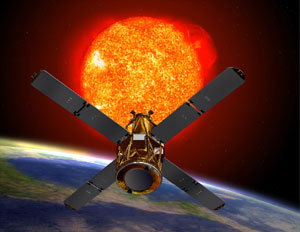|
HOME | SEARCH | ARCHIVE |
|
Time to ‘chill,’ HESSI flight team says
Mission operators must cool spacecraft’s imager before mission begins
![]()
By Diane Ainsworth
Public Affairs
| |  A NASA simulation shows solar flares streaming toward Earth and HESSI. The Berkeley satellite will record data from the flares to help scientists understand space weather. NASA illustration |
06 June 2001
|
After dropping from the belly of a modified jet airplane at 40,000 feet over the Atlantic Ocean and blasting into low-Earth orbit, NASA’s new High Energy Solar Spectroscopic Imager will spend the first two weeks of its life “chilling.” To do that, the staff operating the Samuel L. Silver Space Sciences Laboratory’s specially equipped ground station will activate an 36-foot-diameter antenna dish perched outside the facility and send commands to the four-winged spacecraft to lower its temperature. With a single instrument onboard, the spacecraft will turn on its cryocooler and drop the instrument’s temperature to a chilling 75 degrees above absolute zero. “The cool-down phase shouldn’t take longer than about five days,” said Manfred Bester, an associate research physicist and mission operations scientist, who assembled the ground data system. “These detectors, which are the largest and most advanced array of germanium detectors ever flown in space, are hermetically sealed inside a cryostat that will maintain them at –324 degrees Fahrenheit during the two-year primary mission. After the detectors are cooled, we will begin to collect science data.” HESSI will join a fleet of internationally managed missions that are imaging violent Sun explosions, flares and immense coils of hot, electrified gas shooting into space during solar maximum. Following in the footsteps of its predecessor, the Solar Maximum Mission, HESSI will circle the Earth at 373 miles above the surface — at the same altitude from which the Hubble Space Telescope spies the icy orbs of planets and moons inside and beyond our solar system. On the horizon, the spacecraft will arc over the Bay, transmitting data during the 10 minutes of each pass, explained project manager Peter Harvey. As it comes into view of the antenna, an automated tracking program aims the antenna dish toward the spacecraft and turns the antenna transceiver on to receive data. “The dish, which is outfitted with the latest signal-processing and data-acquisition systems, is as sensitive as a 13-meter dish,” said Bester, who built and maintains it. “All of these daily operations will be performed automatically once we have completed our initial checkout, and that will free the HESSI team from the laborious task of 24-hour monitoring.” In all of its fury, the Sun will gush a cascade of fireworks, conceived from deep within its seething interior. According to Robert Lin, a Berkeley physics professor and HESSI principal investigator, the Sun’s energy, bubbling up to blotch the surface, stores the energy released in solar flares, big explosions that sometimes shoot fountains of white-hot plasma hundreds of thousands of miles into space. Training its nine eyes on solar flares, HESSI will allow scientists to witness in fine detail how rapidly these solar flares can accelerate particles to high energies in the Sun’s outer atmosphere. “These are the most powerful eruptions in the solar system,” Lin said. “In just a few seconds, a flare can explode with as much energy as a billion megatons of TNT and heat material to tens of millions of degrees. Often flares are accompanied by coronal mass ejections that can escape the Sun and crash into Earth’s electrified upper atmosphere, producing communications blackouts, nighttime auroras over the poles and sometimes major power failures.” All in all, the primary mission will yield a scientific bounty of about 1 terabyte of data, enough to fill 1,500 CD-ROMs, according to Lewis. The data will add to the growing body of knowledge about the sun’s inner workings and help scientists predict space weather. “We live in a world of wireless communications and technologies that are based on orbiting satellites and global positioning systems, so it behooves us to understand the Sun’s impact on our atmosphere,” Lin said. “Some day we would like to be able to predict solar storms and other adverse space weather in enough time to prepare for them, just as we are able to predict hurricanes and severe storms on Earth.”
Links:
That might seem odd for a spacecraft designed to study the roiling, multimillion-degree heat of eruptions and flares spewing from the sun during solar maximum, said one of HESSI’s ground controllers. Nevertheless, the team’s first order of business at Berkeley’s Mission and Science Operations Center will be to cool down nine large germanium crystal detectors — HESSI’s “eyes” on the Sun — from their toasty room temperature at launch to a frigid minus 324 degrees Fahrenheit.
Passing over the Berkeley Mission and Science Operations Center six times per day, the intrepid, 645-pound spacecraft will travel faster than the speed of a bullet, Bester said. Clocking 16,900 miles per hour, HESSI can fly “from here to the Golden Gate Bridge in about a second and a half,” said Bester, beaming like a proud father. The spinning craft requires no more than 370 watts of power — just a bit more than a 300-watt light bulb — during the day and 220 watts when it is in Earth’s shadow to send back two years’ worth of high-fidelity data, which will be processed into images and videos.
Home | Search | Archive | About | Contact | More News
Copyright 2000, The Regents of the University of California.
Produced and maintained by the Office of Public Affairs at UC Berkeley.
Comments? E-mail berkeleyan@pa.urel.berkeley.edu.